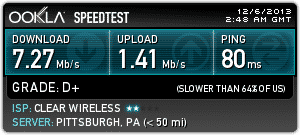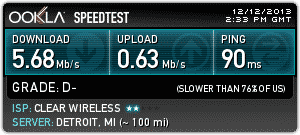Device
The white and black, cookie-sized Karma Wi-Fi hotspot fits into the palm of my hand nicely. There’s only one button: the power button. Hold down to turn it on, hold down to turn it off. Three LEDs show power, Wi-Fi activity, and 4G activity.



The rear of the device has a little door covering the micro USB port used for charging. That’s right – micro USB! Use your phone’s charger cable to recharge the battery inside the hotspot. The battery is rated for 6-8 hours. In my real-world usage, I found that estimate to be accurate.


Service
Karma’s hotspots use Clearwire’s 4G WiMax network for access. As such, coverage isn’t what you think it may be. It’s limited to primarily to metropolitan areas. I’ve got solid coverage in Pittsburgh, but when I go north to visit family, I’ll have to rely on my phone tether for EDGE speeds, as I have for years, when I’m not at someone’s house or business with WiFi. I’ve used the Karma in Cleveland, Ohio, as well, and not had problems where I was near the Cleveland International Airport.
I logged into the device using my email and password combination that I’d set up when I purchased the hotspot. Also available is social login via Facebook. Visiting 192.168.1.1 in my browser redirected me to the login page via a captive portal to yourkarma.com.

I really would like to see some kind of throughput meter and associated client information.
I used Speedtest.net for throughput testing and got a good sample. Most downloads in Pittsburgh where between 7-8 Mbps and most uploads were between 1-2 Mbps. Ping times were decent, usually 70-120 ms. The first badge is from a test at my home in Pittsburgh, while the second is from within the Cleveland I-X Center, a giant metal building that is known for being a bit of a cellular battery killer.

Data costs $14 per gigabyte for 1 GB down to $10 per gigabyte for 10 GB. There’s a 5 GB package for $60. You can pay with credit card, PayPal, or Bitcoin. These prices are great for folks who need connectivity but not a whole lot of bandwidth.
The best way to calculate your economy is based on the $10 for 10 GB plan, or $1 per gigabyte. If your monthly mobile data usage per dollar exceeds that ratio, then Karma is worth it for you. If your cost per gigabyte is cheaper, then Karma is not for you!
For a quick comparison, I looked at some of the common providers I see at the events I attend. As of December 12, 2013, T-Mobile charges $70/mo for 10.5 GB, plus $72 device cost. Verizon charges $60/mo for 10 GB, plus a $20 line cost, totalling $80/mo with a free device. FreedomPop charges $29/mo for 4 GB, and 1¢ per MB after for a total of ~$90/mo for 10 GB, plus $30 device cost. FreedomPop is the only other than Karma that offers “rollover” data, but at a cost. It may add up, though, for casual users. FreedomPop also has a monthly minimum data usage to avoid a charge. While there may be some discounts on these prices available, Karma might end up being the best deal in the end. The others have significantly better coverage, though. Your mileage my vary.
Karma is rolling out new devices in 2014 on Sprint’s LTE network. This will drastically improve coverage and speeds. Karma has promised that a GB is a GB and data bought now will be usable on LTE, and that folks who bought a WiMax device will be able to purchase the LTE hotspot at a significant discount.



